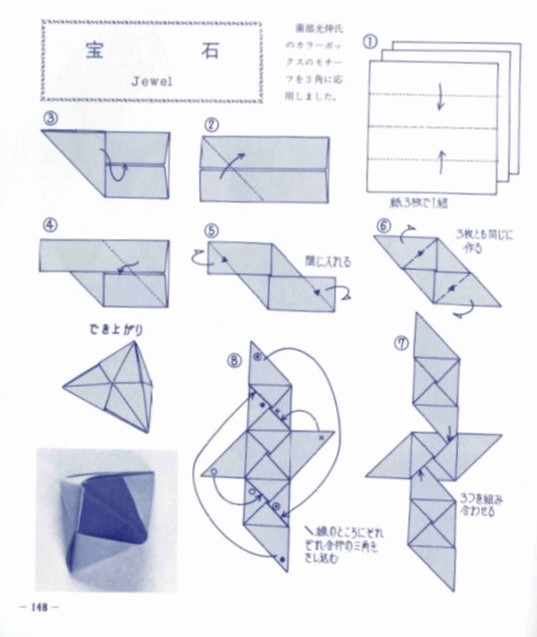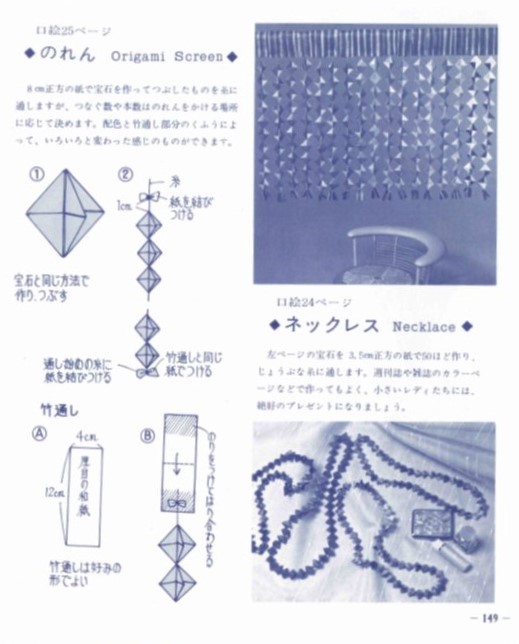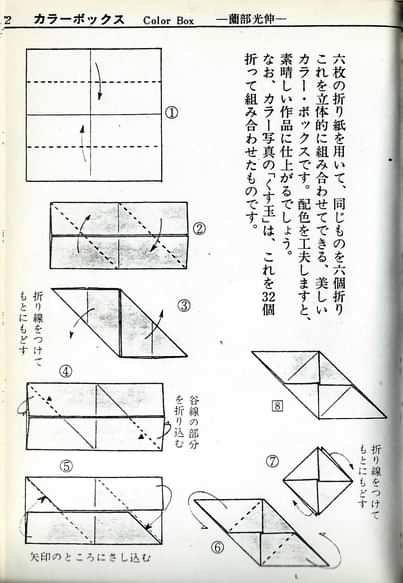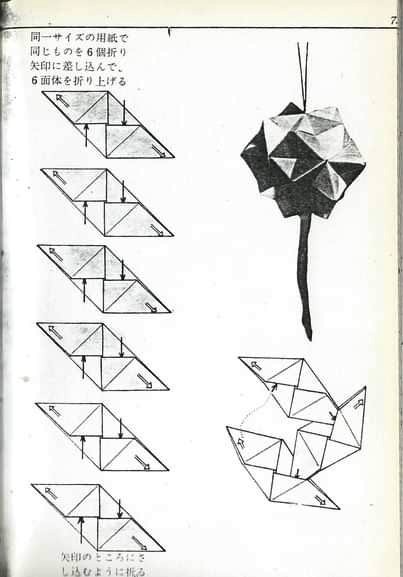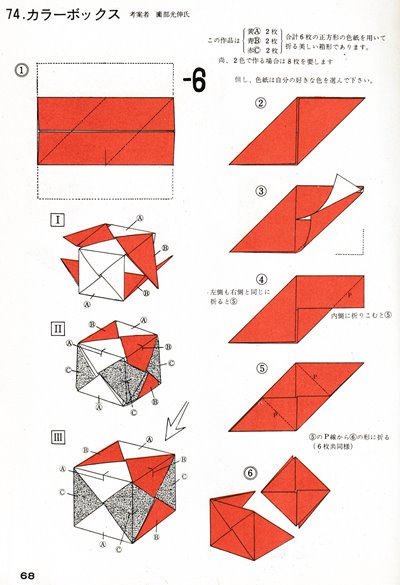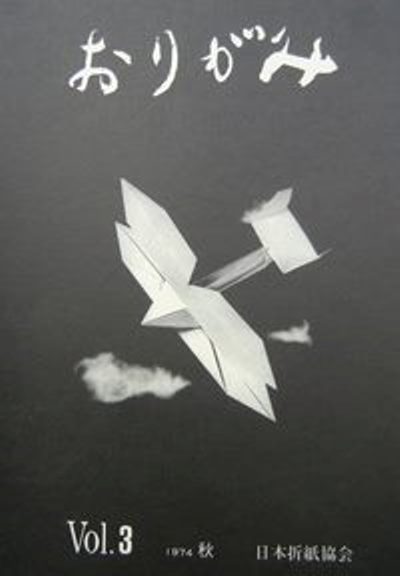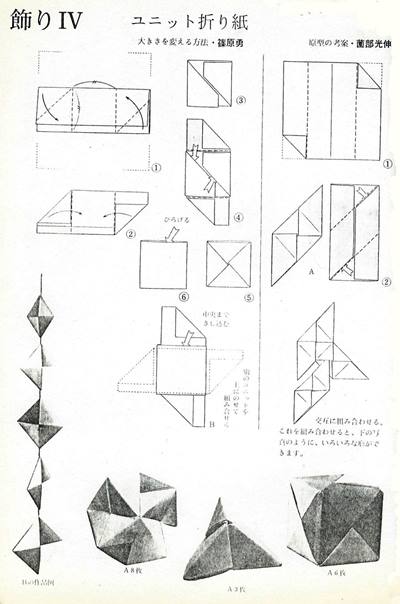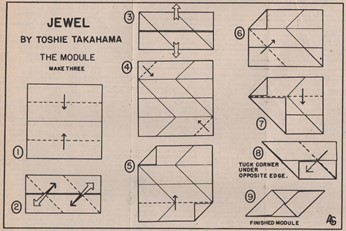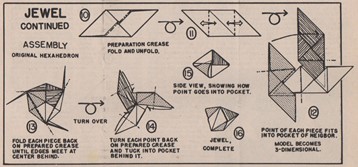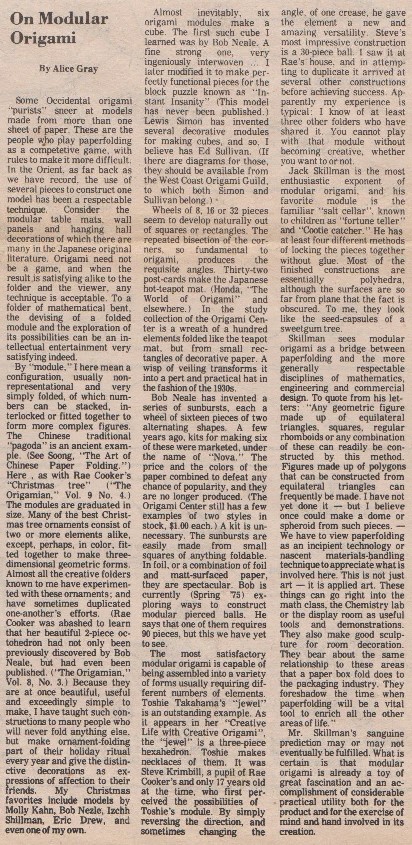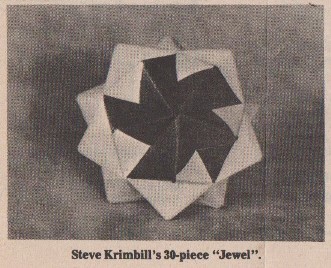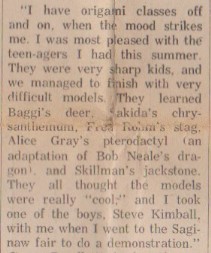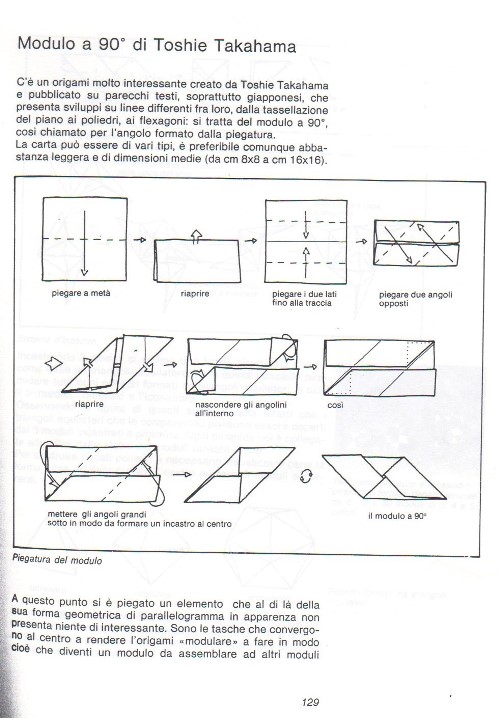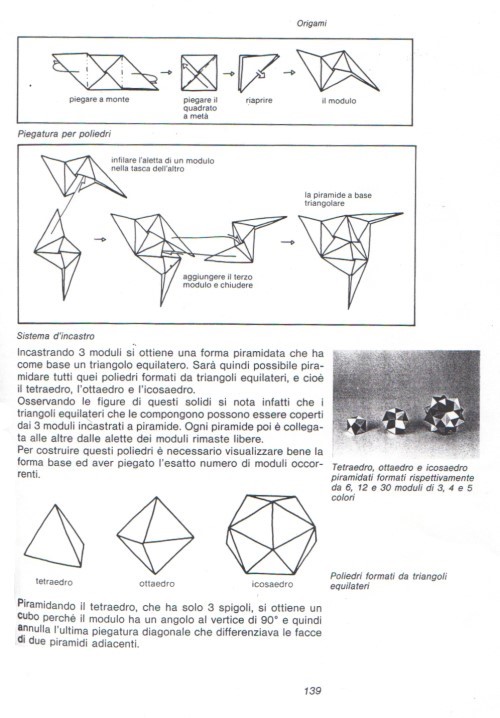| The Public Paperfolding History Project
Last updated 23/12/2024 x |
|||||||
| The Sonobe Module | |||||||
This page is being used to collect information about the history of the paperfolding design known as the Sonobe Module. Please contact me if you know any of this information is incorrect or if you have any other information that should be added. Thank you. ********** Introduction There are various forms of the Sonobe Module: The original form - which I will just call the Sonobe Module. The Simplified Sonobe Module designed by Kunhiko Kasahara. The Corner-Pocket Sonobe Module aka the Tomoko Module (probably first designed by Tomoko Fuse). (All of these parallelogram variants can also exist in mirror-image versions. The W-configurations of these modules (ie those that can be used to make stubby stars) can also exist in alpha (normal) and beta versions (ie with the diagonal crease arranged in the alternate direction across the central square). The Delta Sonobe Module (which does not have rotational symmetry). (All of these types of modules also have many decorative variants). ********** There is some confusion in the literature as to whether this module is a traditional design or was originated either by Mitsunobu Sonobe or Toshie Takahama (who were close friends). In the mid 1990s I had an email exchange with Mitsunobu Sonobe, not directly, but, because he spoke no English, through a close friend of his in Japan, who spoke English fluently. In the course of that exchange he confirmed to me that he was the originator of the basic module and that he used it first to create the six-part cube and subsequently to make both a twelve-part cube and the twelve-part stubby star. He also confirmed that it was Toshie Takahama who originated the three-part silverhexahedron, or 'Jewel', using the module that he had designed. Unfortunately I cannot now find the print outs of that correspondence that I made at the time and so cannot provide documentary evidence to back up these assertions. The evidence confirms that Mitsonubu Sonobe was the designer of this module. There is no evidence that it was independently discovered by Toshie Takahama, although the 3-part silverhexahedral assembly does appear to be her discovery. In the USA, the 30-part Stubby Star form appears to have first been found by Steve Krimbill. This form may well have been previously discovered in Japan, but at present I have not seen any definitive evidence that this was the case. ********** Chronology 1968 According to David Lister the basic Sonobe Module was first published in 1968 in the second magazine published by the Sosaku Origami Group 67 (see David Lister on the Sonobe Module) of which Mitsunobu Sonobe was a member (along with Kunihiko Kasahara and Toshie Takahama among others). I have not seen a copy of this magazine, but it is said to have contained diagrams for what Mitsunobu Sonobe called a 'Color Box'. which was in fact a cube made from six basic Sonobe modules (although they were not called that at the time). David Lister further states that 'The caption to the drawing of the finished model has the words in English: "Finished model by Sonobe Mitsunobu" ... which ... 'leaves unanswered the question whether Sonobe was the originator of the module itself or merely created the composite cube from a pre-existing module.' It seems likely to me, however, that, at least initially, it was not appreciated that the Sonobe module would make anything apart from the six-part cube, so that the emphasis in the diagrams was on the finished cube and not on the module from which it was created, and that consequently these words should not be taken as implying that the module was not Mitsunobu Sonobe's design. Kunihiko Kasahara has confirmed that 'about a year after we formed the group, Mr. Sonobe came up with his “Color Box'' (private email to Nobuko Okabe, translated by her.) ********** 1969 'Creative Life with Creative Origami 1' by Toshie Takahama, which was published in Japan, in Japanese, in 1969, contains diagrams for Toshie Takahama's three-piece 'Jewel' assembly from Sonobe modules and for a screen and necklace made by crushing the 'Jewels' flat and threading them together. Information from Maaike Kok. (Note the author does not appear to be aware that the crushed 'Jewels' will pop back into shape if pressed at both ends simultaneously.) The wording at the top of the first page reads 'I used the module of the 'Color Box' by Mr. Mitsunobu Sonobe to make the triangular shape.'
********** 1970 'Atarashi Origami Nyumon' by the Sosaku Origami Group '67, which was published by Nihon Bungeisha in 1970, also contains diagrams for the basic module and the 6-part Color Box. It also mentions and illustrates the 30-piece Stubby Star, which is called a 'kusudama'.
*** The basic module and the 6-part Color Box also appear in 'Origami Nippon' by Isao Honda which was published by Honda Origami Studio in Tokyo in 1970. The design is clearly attributed to Mitsunobu Sonobe.
********** 1974 Diagrams for the Sonobe module (see right hand column), alongside photos of the six-part cube, three-part silverhexahedron and twelve-part stubby star assemblies, were published in Volume 3 of the NOA magazine in 1974. The column is headed ' Prototype idea: Mitsunobu Sonobe'. Information from Juan Gimeno.
(It is worth noting that this magazine does not include a photograph of the 30-part Stubby Star (my nomenclature) which may still not have been discovered at the time.) ********** 1975 Vol 13 issue 3 of the Origamian, which was undated, but, according to David Lister (see link above) published in June 1976, contained diagrams for a 'Jewel' attributed to Toshie Takahama which was made from three Sonobe modules (although Mitsunobu Sonobe was not credited with its invention).
The same issue contained an article written by Alice Gray titled 'On Modular Origami'. The article mentions Toshie Takahama's 'Jewel' and states that 'Toshie makes necklaces of them.' It also states that 'It was Steve Krimbill, a pupil of Rae Cooker's, and only 17 years old at the time, who first perceived the possibilities of Toshie's module. By simply reversing the direction, and sometimes changing the angle of one crease, he gave the element a new and amazing versatility. Steve's most impressive construction is a 30-piece ball. I saw it at Rae's house, and in attempting to duplicate it arrived at other constructions before achieving success.' Again, no mention of Mitsunobu Sonobe is made.
(Steve Krimbill is the same person, there called Steve Kimball, who was mentioned in Alice Gray's profile of Rae Cooker in Vol 9: Issue 4 of 'The Origamian' for Winter 1969.)
********** 1976 Diagrams for the Sonobe module may also have appeared in a book by Kunihiko Kasahara published in this year, for which the English translation of the title is said to be 'Unit Origami'. I have not seen a copy of this book . ********** 1977 Diagrams for 'Sonobe Units' appeared on p34 of NOA magazine issue No. 9 of February 1977. Source: NOA Magazine 9 Book Review | Gilad's Origami Page. I have not seen a copy of this magazine. ********** 1984 Diagrams for the Sonobe Module, but attributed to Toshie Takahama rather than Mitsunobu Sonobe, and how to make numerous assemblies from them, were published in 'Il Libro Dei Rompicapo' by Giovanni Ravesi, Dario Uri and Luisa Canovi, which was published by Sansoni Editore in Italy in 1984.
********** 1987 Diagrams for the Sonobe Module were also included in 'Origami for the Connoisseur' by Kunihiko Kasahara and Toshie Takahama, which was published by Japan Publications in English in 1987. (The work had been previously published in Japan in Japanese by Sanrio Co Ltd in 1985, but I have not seen a copy of that work and do not know if the two works were exactly identical in their content.) The introduction to the section dealing with the Sonobe Module says, 'I begin with the Sonobe Module, which can be called the point of origin of modular origami. Mitsunobu Sonobe, its originator, calls it a color box; but I have preferred the conveniently applicable term Sonobe Module.' (Since Toshie Takahama is one of the authors this statement effectively resolves the question of whose design it was.) The work also contains diagrams for two variations of the basic design, the Simplified Sonobe Module by Kunihiko Kasahara and the Corner-Pocket Sonobe Module (here called the Tomoko Unit, presumably because it was designed by Tomoko Fuse). In a section entitled 'Exploring the Multimodular Sphere' (effectively adding pyramids made from Sonobe Modules to the faces of deltahedra) the authors say, 'with the co-operation of some of his students, Professor Matsao Matsuzaki ... increased the possible sphere size to 900 units.' The work also contains several images of angular sculptures of animals, and a bird, made using basic Sonobe Modules. A full copy of this work can be accessed here. (Note that he date of publication given in this record is incorrect.) ********** |
|||||||
